Room 2 “Fede Ruiz”: ARTISTIC Exhibitions
150 m2 room (floor -1) dedicated to exhibitions of established artists: painters, photographers, sculptors… Four annual exhibitions are scheduled, lasting two and a half months each.
150 m2 room (floor -1) dedicated to exhibitions of established artists: painters, photographers, sculptors… Four annual exhibitions are scheduled, lasting two and a half months each.
 This young photographer from Okondo (Araba-Álava) brings to the “Fede Ruíz” Art Exhibition Hall of the Orduña Museum/Orduña Hiria Museoa landscapes, fauna and flora native to our immediate surroundings, through his gaze as a photographer who, despite his youth, has achieved great mastery.
This young photographer from Okondo (Araba-Álava) brings to the “Fede Ruíz” Art Exhibition Hall of the Orduña Museum/Orduña Hiria Museoa landscapes, fauna and flora native to our immediate surroundings, through his gaze as a photographer who, despite his youth, has achieved great mastery. Xabier Ramos Rodríguez
Xabier Ramos Rodríguez 


The artist born in Bilbao (Vizcaya, Basque Country) Mª José Ardanaz, based in Orduña (Vizcaya, Basque Country) where she has her painting studio, will open an exhibition on Friday 4 October at 7 pm in the “Fede Ruiz” Art Exhibition Hall of the Orduña Museum and will remain open until 6 January next year.
It is a retrospective exhibition where she will show us works from all the experiments of her career in thirty paintings with different themes and styles: portraits, landscapes, still lifes, bullfighting, etc.
Her passion is painting but she likes to work with different formats and materials such as photography, drawing, modelling with clay, earthenware, porcelain, writing, bookbinding, design and tailoring and digital design and in the exhibition she will also show her facet as a designer of dresses for classical dance.
Mª José began to take painting seriously after taking early retirement and, to the surprise of her fellow students, she graduated in Fine Arts from the University of the Basque Country (EHU) in 2010, being the “grandmother” of her class.ta trabajar diferentes formatos y materiales como fotografía, dibujo, modelado con arcilla, loza, porcelana, escritura, encuadernación, diseño y confección y diseño digital y en la exposición mostrará también su faceta de diseñadora de vestidos para danza clásica.
Mª José empezó a tomarse en serio la pintura después de prejubilarse y para sorpresa de sus compañeros de estudios, se licenció por en Bellas Artes por la Universidad del País Vasco EHU en 2010, siendo la “abuela” de su promoción.


THE EXHIBITION
The museum exhibits works by the patriarch, Lluís Rossell, and four of his children.
They are united by their artistic vocation focused on painting and the creations derived from their professional activity: jewelry that they designed and produced from their businesses in Barcelona.
This exhibition aims to give visibility to the figure of the Catalan artist, Lluís Rossell Pesant (1912-1995), engraver, painter and jeweler; who had a special connection with Orduña.

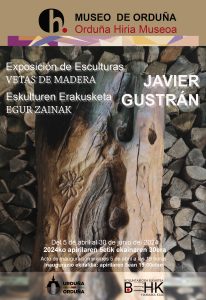

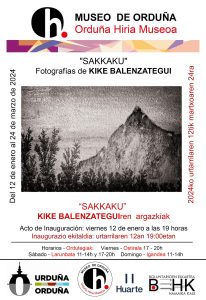

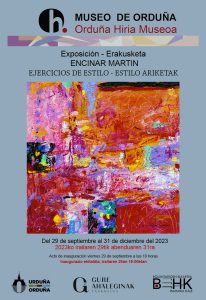
His creativity and curiosity led him to discover and explore, from his youth, different artistic formats such as painting, sculpture, watercolor, woodcut, engraving, digigraphy, drawing, advertising posters, illustrations or design.
In this exhibition the Orduñés artist presents a very varied work in techniques and formats: from 2 large acrylics to formats closer to the classic painting in watercolor, acrylic and mixed, through folding books in the shape of a herringbone and a large painting (5m x 1m) on a support that allows it to be extended and rolled up.
“One of the greatest difficulties that an artist faces when changing medium or support and even size is keeping his identity recognizable in his works. Each technique has its particular characteristics and limitations that must be understood and mastered to achieve a coherent and consistent identification.
When an artist moves from one medium to another, whether from painting on canvas to paper or from drawing to printmaking, he is faced with significant changes in the tools, techniques and materials used. This involves learning new processes and adapting to the peculiarities of painting style. Familiarity with a specific medium can take a lot of time and practice, and switching to a new one may require an additional learning curve.
In addition to the different techniques, each medium has its own visual language, a unique form of artistic communication. When changing from one to another, the artist needs to adapt to new forms of visual expression. This involves developing a new artistic vocabulary and exploring how his personal style can be translated and maintained in the new medium.
Adaptation, “Style Exercises” may be necessary for an artist to feel comfortable and confident when changing medium or type of painting. This involves experimenting with different techniques, exploring new possibilities and taking on creative challenges. Through practice and exploration, the artist can discover new forms of expression and develop a sense of coherence in his work, allowing him to maintain his recognizable identity regardless of the medium used.
The process of deeply exploring and maintaining each technique and step also helps the artist develop a broader and deeper understanding of his own work. By becoming familiar with the different textures, effects, and artistic qualities that can be achieved in different media, the artist gains a more precise vision of his own style and the distinctive characteristics of his work. This allows him to use these techniques and qualities more intentionally and consistently, thus creating greater identification and recognition in whatever medium he chooses.” (Encinar Martin)
<Click on the photo to enlarge>>> 
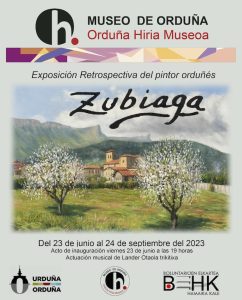
Rafael Fernández ZUBIAGA showed his artistic skills from a very young age. At the age of seven, his drawings stand out among the rest of his classmates and serve as a model for the students of the entire school. Nine years old and guided by his father, who was a shoemaker by profession and a self-taught cartoonist, he makes enlarged copies of photographs, in pencil and charcoal, which strongly attracted attention.
Driven by his instinct, at the age of fourteen he begins to paint in oil. With few technical resources, he paints corners and landscapes of his region. In Orduña he met the renowned artist Bay-Sala who was painting in the city. For Zubiaga it was “the most important meeting of his life.”
Encouraged and advised by the painter, at the age of fifteen he left the family business and decided to embark on an artistic path. They travel to Madrid to visit museums and art galleries, they tour the Basque Country painting landscapes…, thus he cements his technical knowledge and strengthens his artistic vocation.
At the age of seventeen, he began his journey alone, he traveled the Peninsula and North Africa, honing his skills as a landscaper. In his works, light and color are the main protagonists.
At eighteen he held his first exhibitions, with great success, in Bilbao and Vitoria. In the capital of Biscay, the painter “Bay-Sala” gives him the alternative and introduces him to the artistic world as his disciple: “The interest shown by that blond boy in seeing me paint caught my attention; he asked questions and I answered… arose the disciple”.
In 1956 he established his residence in Arrasate (Gipuzkoa) and put aside his artistic career, absorbed by the business that he founded in the locksmith town.
At the end of the 1990s, after 42 years of interruption, he set up his easel again, reunited with his beloved and long-awaited Basque landscapes, toured several countries, and reflected in each of his new brushstrokes the renewed soul of the artist, that captures the most vivid elements of nature, impregnating them with light, color and perspective.
In an interview with the Diario Vasco in 2017, it was said: ”Since he dusted off his easel upon retirement, this landscape painter who signs as Zubiaga has not given up with his brushes. «I have painted 604 paintings» he recounts with obvious pride. His artistic production progresses at a rate of thirty canvases a year and he has already sold half of his funds ”.
The artist Gerardo Fontanes wrote in one of Zubiaga’s latest catalogues: “Zubiaga’s naturalist painting has high risks, but also notable virtues: as many as can be summarized by being works at first intention, provoked by his own experiences and carried out “in situ” with the purpose of reproducing an emotionally attractive image or figuration for the viewer”.
<Click on the photo to enlarge>>>

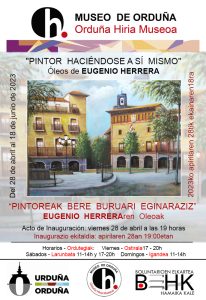
Eugenio Herrera Sánchez born in 1941 in a humble family and village of shepherds, the youngest of four brothers, He is a self-made painter, self-taught, he has never had a teacher or person to teach him.
Born in the countryside, his fondness for painting was awakened as a child when he was impressed by a painting he saw. With his meager means he began to paint and his dream, when he went to town, was to find a magazine with people’s faces and then he, in the field, in his own way, on paper or stone or wherever he could, paint them.
His school has been nature, landscapes, towns, people, their faces and always the intention to do it better and as close to reality as his eyes see. Slowly, with care, calmly, without haste, with love for his brushes, canvases, oils, lights and shadows, faithful to his thoughts and ideas. With an observant look and eager to learn and improve, he studied very carefully the paintings of the greats.
He spent hours and hours in the Prado Museum and the art galleries of Madrid while he alternated time with the study of the first color televisions for which he became a radio and television technician.
Portraits, freehand portraits, looking at the original and next to it, the blank canvas; starting from a point, a line, a silhouette until forming the volume that the human figure acquires, many “comes and goings” on the canvas, pauses and brushstrokes, patience, waiting, observing, one layer on another, hours and hours in solitude from his attic, until he achieves an expression and eyes that reflect the soul of the person.
He tells: the important thing is not “what is done” but “how it is done”. “I paint within my possibilities, with the idea that when you look at one of my paintings your eyes will be hooked and you will feel the impression that you are inside the painting and you can walk through it or that you are really seeing, at that precise moment. , to the person portrayed”.
“My intention when I paint is to get closer to the reality that my eyes see and bring it as faithfully as possible to the blank canvas; for me no painting is finished, because all can be improved; when I finish a painting I think and feel that the next one I can do better; the day I can’t improve, I stop painting”.

It is the first time in his life that Eugenio is going to have the opportunity to see his paintings all at the same time, in the same room, in the same look, it is his illusion and it is his wish that you enjoy As the.
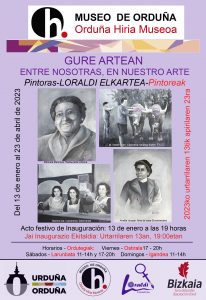
LORALDI ELKARTEA
The women’s association of Orduña LORALDI Elkartea has been fighting for equality in the city for nearly four decades, carrying out activities of a different nature, such as talks and conferences on topics of interest to women, video forums, cultural excursions, and courses of different disciplines like the Artistic Creation Workshop.
With this exhibition, LORALDI Elkartea wants to show a gallery of strong women, treated from the point of view of many other women of different professions, economic and social situations, and origins, but with a common link: women who like to paint.
In their own words “we have tried to give their predecessors their place, to use OUR ART to recognize those women who lived AMONG US and who are referents for future generations as they were for ours, driving us to be who we are”.
EXHIBITION
The exhibition is divided into two main sections, WORK and LEISURE, and a third, THE FUTURE.
In the first, a series of women known for their profession are presented, although in the painting they may be posing and not working. Although the professions they held could be within the stereotype, they were no less important.
The second is in turn divided into two other sections, SPORTS and PARTY, linked by the common thread of TRANSPORT. Several women are presented here in different free time situations, walking, cycling, riding a motorbike… but always taking the reins of their lives, which is why they are in this exhibition.
The third part is based on a small fusion of all of them in what they have called THE FUTURE with women from later generations in similar situations, since “BECAUSE THEY WERE, WE ARE; AND BECAUSE WE ARE, THEY WILL BE”.
Accompanying these paintings, old, group photographs, of women working or partying, are exhibited, which are introduced maintaining the way they were presented, without removing elements or adding paint. A small selection of photographs and other documents, as well as the materials used, help to better understand the process. In addition, current photographs of the hands and the women of women that have worked on the creations in this exhibition.
CREATIVE PROCESS
All the works are made from photographs, some very old, both in color and in black and white. After converting all of them to black and white, with photocopies in a mirror effect, a “transfer” gel was applied to them to transfer the image to the canvas. Subsequently, the cellulose is removed from the paper and, after applying the gel again, once dry, it is painted over the image that has been transferred.
In all the works, an element has been selected to be highlight ed in purple, since the main objective of this exhibition is to recognize the work of these women who, without knowing it or wanting to, were pioneers.

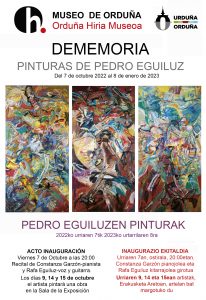
The Orduña Museum presents this exhibition in the “Fede Ruiz” room where you can see a selection of large-format works, as well as small paper works, all of which Pedro Eguiluz titled “DEMEMORIA” (from memory), alluding to a creation process that doesn’t come from sketches.
Pedro Eguiluz is a painter, illustrator and cartoonist born in Orduña (Bizkaia) on April 7, 1948.
Pedro gave ride to his passion for painting at a very young age, and belongs to the second promotion of graduates from the then High School of Fine Arts in Bilbao (1971-1976).
Throughout his extensive career, he has exhibited his works in important galleries and museums, among which we can mention: San Telmo Museum in San Sebastian (1978), Arteder Fair in Bilbao (1983), Montehermoso Center in Vitoria (1988), Cervantes Institute in Casablanca, Morocco (2001), Bogotá Art Museum (2003) and Ceuta Museum (2008).
Pedro Eguiluz’s work has evolved from figuration, through abstract and gestural expressionism, to what can currently be called conductionism.

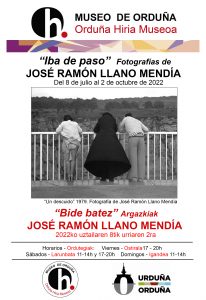
José Ramón Llano Mendía is an amateur photographer with almost a life dedicated to photography. During the 80s, he basically devoted himself to black and white in analog mode in his home laboratory, actively participating in photography contests and clubs. After a break of several years due to work reasons, when he reached his professional retirement, he resumed his photography hobby, already in its digital mode, forcing him to a strong and innovative set-up.
He has always been linked to photography associations where knowledge is acquired and shared with younger enthusiasts. In short, associations are places of common passions and friendship.
The long career of José Ramón Llano would make a retrospective exhibition very extensive. His interests within photography have evolved in techniques and themes: from black and white to color, from chemical to digital, from portrait to landscape, going through the most varied themes. For this exhibition José Ramón has chosen to show 44 photographs organized into four series: “MEMORIES”, “ABSTRACTIONS”, ARCHITECTURES” and “NATURES”.


His long and eclectic artistic journey culminates with this exhibition that opens in his host city. The strength and energy that his new works transmit, will not leave anyone indifferent. They reflect the transforming power of fire over nature and, although they are abstract works, their power of evocation is capable of awakening the deepest emotions.
The generosity and altruism of Porrilló with Orduña comes from afar. He participated in that 80s mythical painting school that was a reservoir for good Orduña’s artists. More recent was his contribution to the extraordinary realization of the permanent exhibition on the gables´ ceelings of the Foru Plaza. In addition to his contribution of two murals, he also achieved the participation of many of his artist friends. Today, it constitutes a first level artistic heritage for our city.
Those who have followed Porrilló’s artistic career, in which he has worked in all genres, from landscape to still life; in stages with very different styles, from impressionism to abstract expressionism through realism; and with infinite investigations of materials and techniques, do not hesitate to define Porrilló as a brilliant artist.

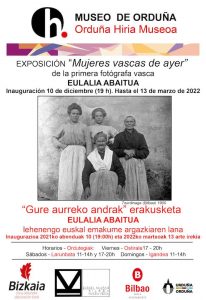

This renowned photographer and documentary maker, who in his long career has been the recipient of great awards and scholarships, including twice winner of the World Press Photo, presented the exhibition “Child Labor Exploitation” in his hometown.